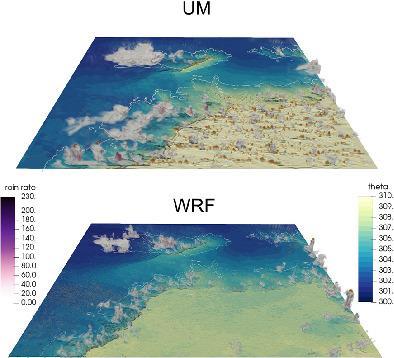当前位置:
X-MOL 学术
›
Q. J. R. Meteorol. Soc.
›
论文详情
Our official English website, www.x-mol.net, welcomes your
feedback! (Note: you will need to create a separate account there.)
Locally forced convection in subkilometre‐scale simulations with the Unified Model and WRF
Quarterly Journal of the Royal Meteorological Society ( IF 3.0 ) Pub Date : 2020-07-01 , DOI: 10.1002/qj.3855 M. Jucker 1, 2 , T. P. Lane 2, 3 , C. L. Vincent 2, 3 , S. Webster 4 , S. A. Wales 2, 3 , V. Louf 5, 6
Quarterly Journal of the Royal Meteorological Society ( IF 3.0 ) Pub Date : 2020-07-01 , DOI: 10.1002/qj.3855 M. Jucker 1, 2 , T. P. Lane 2, 3 , C. L. Vincent 2, 3 , S. Webster 4 , S. A. Wales 2, 3 , V. Louf 5, 6
Affiliation

|
This study evaluates the performance and benefits of kilometre‐ and subkilometre‐scale convection‐permitting simulations over tropical Australia. Focusing on an extended monsoon break period, we can directly compare Unified Model (UM) and Weather Research and Forecasting model (WRF) simulations to C‐band polarimetric radar observations and soundings. We show that the two models have different behaviour, and both are different to observations. Whereas WRF produces daily squall lines whether or not they occurred in observations, the UM primarily generates small but intense storms. The UM and WRF produce qualitatively different surface density currents at different times in the diurnal cycle. Once the density currents are present, the models also show different behaviour in relation to convective initiation. While higher resolution helps in the distribution of total precipitation over the domain, most characteristics do not change with higher resolutions, and model differences are always larger than resolution differences. While Convective Available Potential Energy/Convective Inhibition (CAPE/CIN) does not seem to be important to explain model differences, our findings point to the evolution of density currents in the boundary layer as the most important source of model errors and differences.
中文翻译:

使用Unified Model和WRF在亚千米尺度模拟中的局部强制对流
这项研究评估了在澳大利亚热带地区进行公里和亚公里尺度对流允许模拟的性能和好处。着眼于延长的季风休息期,我们可以将统一模型(UM)和天气研究与预报模型(WRF)模拟与C波段极化雷达观测和测深直接进行比较。我们表明,这两种模型具有不同的行为,并且与观察结果不同。不管是否在观测中发生,WRF都会产生日常的qua线,而UM主要产生小而强烈的风暴。UM和WRF在昼夜周期的不同时间产生质上不同的表面密度电流。一旦出现密度电流,这些模型还显示出与对流引发有关的不同行为。虽然较高的分辨率有助于在整个区域内分配总降水量,但大多数特征不会随较高的分辨率而改变,并且模型差异始终大于分辨率差异。尽管对流可用势能/对流抑制(CAPE / CIN)对于解释模型差异似乎并不重要,但我们的发现指出边界层中密度电流的演变是模型误差和差异的最重要来源。
更新日期:2020-07-01
中文翻译:

使用Unified Model和WRF在亚千米尺度模拟中的局部强制对流
这项研究评估了在澳大利亚热带地区进行公里和亚公里尺度对流允许模拟的性能和好处。着眼于延长的季风休息期,我们可以将统一模型(UM)和天气研究与预报模型(WRF)模拟与C波段极化雷达观测和测深直接进行比较。我们表明,这两种模型具有不同的行为,并且与观察结果不同。不管是否在观测中发生,WRF都会产生日常的qua线,而UM主要产生小而强烈的风暴。UM和WRF在昼夜周期的不同时间产生质上不同的表面密度电流。一旦出现密度电流,这些模型还显示出与对流引发有关的不同行为。虽然较高的分辨率有助于在整个区域内分配总降水量,但大多数特征不会随较高的分辨率而改变,并且模型差异始终大于分辨率差异。尽管对流可用势能/对流抑制(CAPE / CIN)对于解释模型差异似乎并不重要,但我们的发现指出边界层中密度电流的演变是模型误差和差异的最重要来源。











































 京公网安备 11010802027423号
京公网安备 11010802027423号